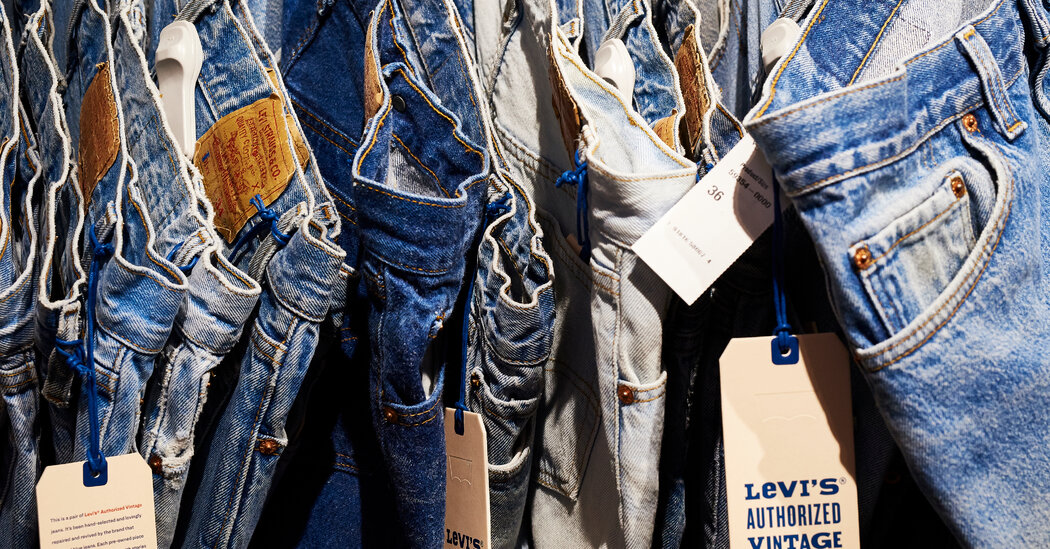
I am in need of new jeans. I haven’t purchased a pair since before the pandemic. I am looking for jeans that are in style and won’t be out in a year. What is the most sustainable approach to denim, in style, material and care? — Katherine, Northport, Ala.
The irony of finding the perfect pair of jeans is that its very discovery contains the seeds of its destruction. After all, once you’ve found your ideal jeans, you wear them, over and over again, until, no matter how hardy they are, you wear them out. And then you’re stuck with the horrible task of trying to replace them.
Which often seems impossible, because even when you’ve bought what you think is a forever pair like, say, Levi’s 501s, it turns out they, and your body, have changed.
(This means that even if you try that classic hack and buy two pairs of the same pants to put one away for the future, it doesn’t always work. What fit a 35-year-old you perfectly does not always fit the 40-year-old you perfectly.)
Besides, there are now so many different kinds of jeans to choose from! Do you want designer jeans, fast-fashion jeans, cult jeans, jeans that claim to be more or less sustainable, dressy jeans, distressed jeans, boyfriend jeans, skinny jeans, selvage jeans, boot-cut jeans, high-waist jeans, low-waist jeans, jeans with stretch or what? Pretty much every brand makes a pair. There’s a reason the denim market is predicted to be valued at around $87.4 billion in 2027, up from $63.5 billion in 2020.
It can seem overwhelming. Especially because denim is highly destructive to the environment, thanks to the dyes involved and the quantity of water used (among other problems). That’s the bad news.
There is good news, however, or so says Maxine Bédat, the founder of the New Standard Institute and author of “Unraveled: The Life and Death of a Garment.” Coincidentally, Ms. Bédat had emailed me when on her way home from the COP28 climate conference, where she had run into the folks from Artistic Milliners, Pakistan’s first Fair Trade-certified denim manufacturer — a company she said produces one in every dozen jeans sold. (They work with all sorts of name brands, including Lee and Levi’s.)
“The single most important factor in clothing in terms of environmental sustainability is how many times you wear a garment,” Ms. Bédat said. In other words, the easiest way to offset the environmental impact is not by buying carbon credits but simply making sure you love a garment and you wear it a lot.
And when it comes to denim, Catherine Holstein, the founder of Khaite and a two-time C.F.D.A. winner of the designer of the year award, had this advice when I asked: “Ignore all sizing,” she said. “Just buy what feels comfortable.” Rather than shoehorn your body into whatever seems popular at the moment, or into the smallest size you can actually zip, select jeans based on what makes you feel good.
“The numbers are meaningless,” Ms. Holstein said. “There’s just someone in a back room making them up.” Personally, she said, she liked her jeans loose and easy to wear.
In terms of composition, look for jeans that are pure cotton (as opposed to cotton mixed with synthetic stretch), which makes recycling easier and, Ms. Bédat said, avoids the microplastic issue. Wash them rarely (Chip Bergh, the chief executive of Levi’s, once told me he never washes his jeans) and hang them to dry, rather than put them in the dryer. If you are worried about bacteria, Ms. Holstein advised putting them in the freezer overnight.
So forget all about that “skinny jeans are in; skinny jeans are out” hoo-ha. And remember: You are the master of your own denim destiny.
Your Style Questions, Answered
Every week on Open Thread, Vanessa will answer a reader’s fashion-related question, which you can send to her anytime via email or Twitter. Questions are edited and condensed.






